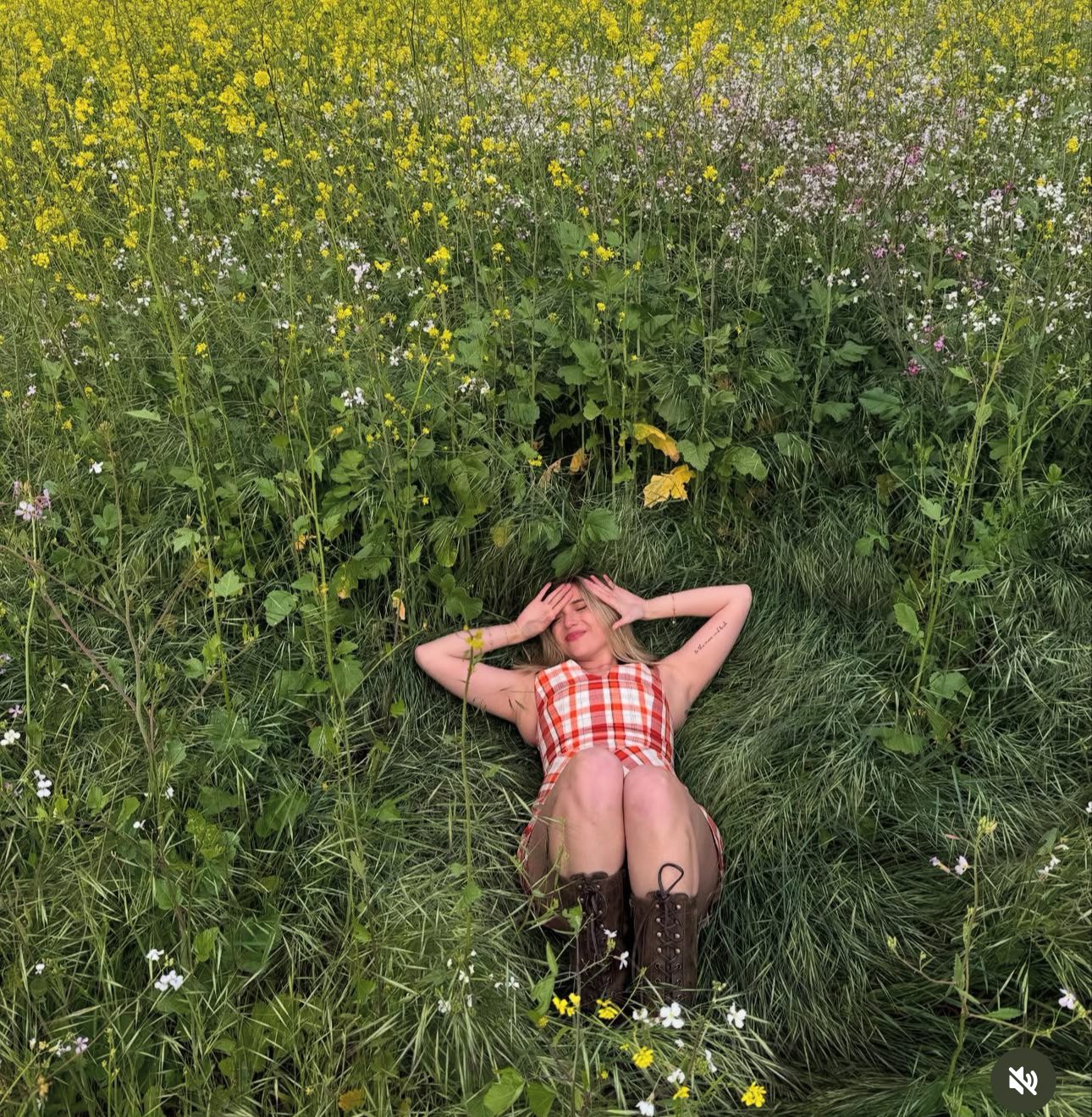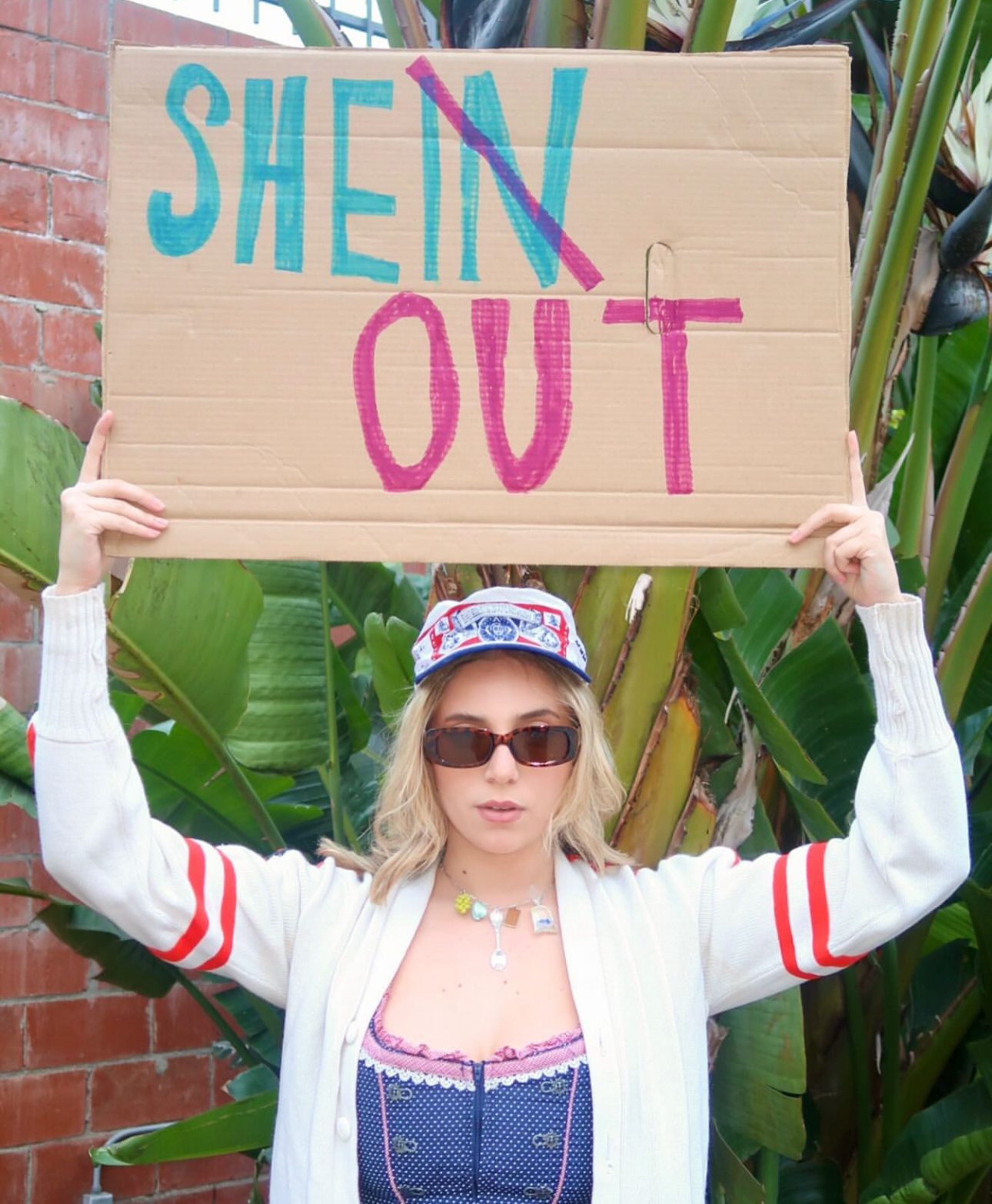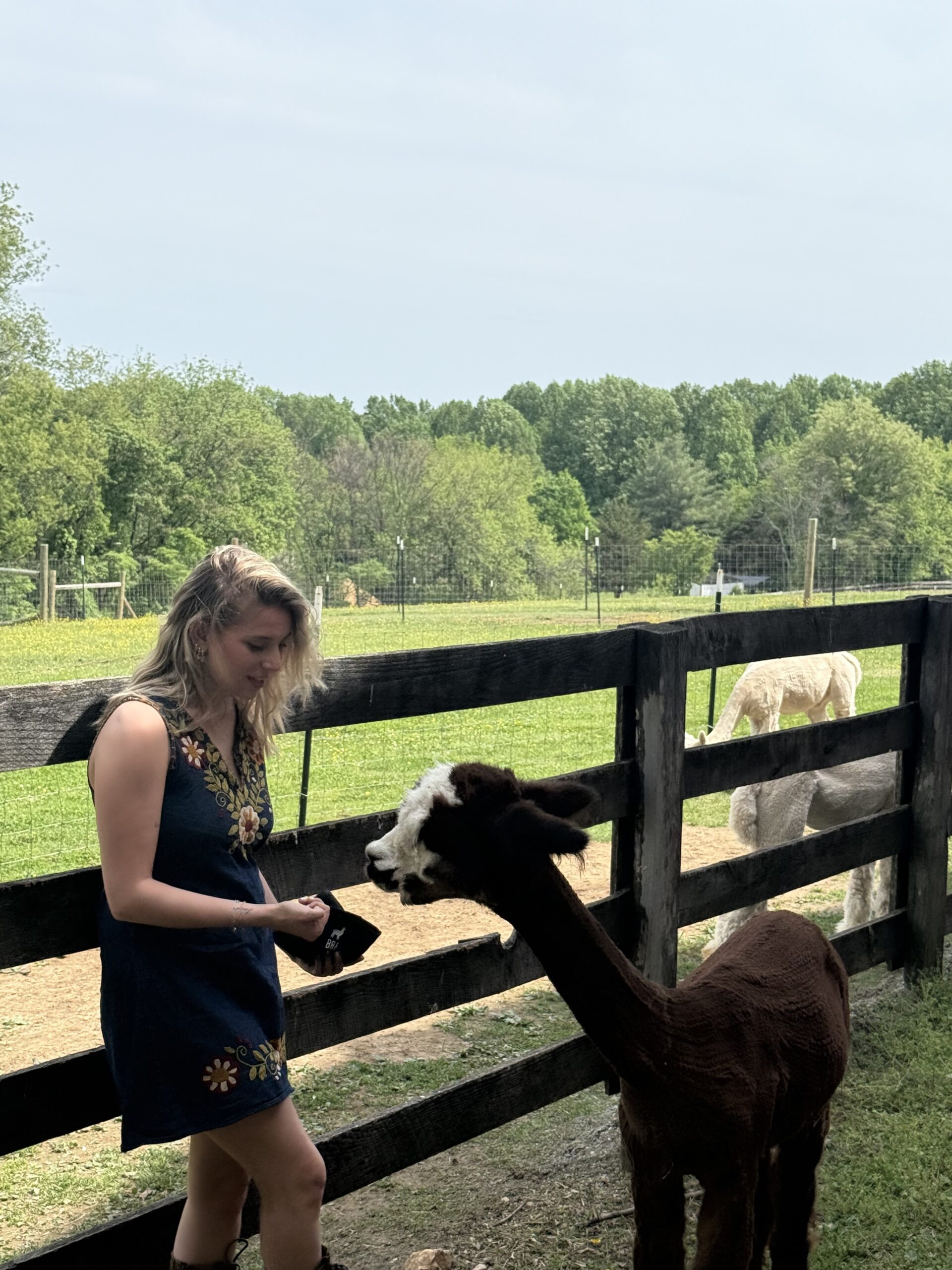Okay, so I didn’t plan on becoming an alpaca person, but after a day at Black Barn Alpacas farm in Maryland, I’m hooked. Honestly, I’m not sure if I want one… or an entire herd.
We met a baby alpaca that was just two hours old, already walking—and even occasionally running—around like a tiny, fleece-wrapped deer. It was undeniably adorable, and honestly, kind of eye-opening. This place isn’t just peaceful and cute. It’s rooted in sustainability and intention.
Alpacas are gentle on the planet, efficient, and honestly don’t get enough credit. So now I’m wondering: why aren’t there more alpacas in the world?
If you’re into mental wellness, conscious fashion, or just need a break from your phone, they’re a pretty solid place to start.
A Quick Alpaca History Lesson (Because, Yes, They Deserve Their Own Origin Story)
Here’s the thing: alpacas didn’t just show up one day looking fabulous and sustainable. These fluffy animals have been around for thousands of years—and they’ve always been kind of a big deal.
Alpacas were first domesticated by the Incas over 6,000 years ago in the Andes mountains. Back then, their fiber was considered so luxurious it was reserved for royalty. Alpaca fleece was basically the original cashmere, known as the “fiber of the gods.” And if you’ve ever touched it, you get it. Soft, warm, lightweight… it’s what your winter coat wishes it was made of.
But then the Spanish came along in the 16th century and colonization happened. European livestock were brought in, native ecosystems were disrupted, and alpacas were pushed to the sidelines—literally up into the remote highlands, where they survived in smaller numbers while the world sort of… forgot about them.
Flash forward to the 19th century: Europeans rediscovered alpaca fiber and thought it was incredible. But it wasn’t until the 1980s that alpacas made their way to the U.S. in any real numbers. The first private imports came from England, and by the early 2000s, alpaca farming was having a bit of a moment. You might even remember when they felt weirdly trendy—showing up in eco-boutiques and farm-to-fiber Instagram posts before #sustainablefashion was a thing.
But like all good things that get hyped too fast, the alpaca boom hit some bumps.
Why? A few reasons: we never fully built the infrastructure needed to process their fiber at scale here in the U.S. Market demand didn’t keep up. And many alpaca farmers were left without a solid supply chain to support their work. According to USDA data, the combined llama and alpaca population in the U.S. dropped by nearly half between 2007 and 2022.
So now? Alpacas are still here—still magical, still sustainable—but they’ve slipped under the radar again. And that’s a shame. Because if we’re serious about tackling climate change, rethinking our relationship with clothing, and prioritizing low-impact farming… then yeah, it’s time to give these gentle, fleece-covered climate heroes the credit (and attention) they deserve.

The Climate Crisis Is Here—So Why Aren’t Alpacas Everywhere?
Climate change isn’t a someday problem anymore. It’s now. It’s record heat, unpredictable storms, water shortages, and supply chains unraveling in real time. And yet, we continue producing fashion in ways that directly contribute to the problem—massive textile waste, microplastics in our oceans, and endless emissions from global manufacturing.
Alpacas are a low-impact, high-reward animal that gives us one of the cleanest, most ethical fibers available.
Their soft, breathable fleece is already nature’s version of high-performance wear—biodegradable, antimicrobial, hypoallergenic, and free from the toxic dyes and plastics used in most modern clothing.
They graze gently. They sip water sparingly. They don’t tear up the land like other livestock. And—okay, I don’t usually talk shit, but here we are—they even go to the bathroom in neat little piles, which makes cleanup easier and turns waste into a usable resource. Yep, alpaca manure is a top-tier natural fertilizer. Zero waste, maximum efficiency.
In other words? They do everything right—and still get overlooked.
So… Why Don’t We All Have Alpaca Sweaters That Are Biodegradable and Locally Made?
If alpacas are that sustainable—and trust me, they are—why aren’t our closets full of alpaca socks, sweaters, and scarves made right here in the U.S.?
Great question. And like most great questions, the answer’s a mix of history, logistics, and… capitalism.
Let’s start with Peru. That’s the alpaca capital of the world—home to roughly 80% of the global alpaca population. For thousands of years, Andean communities have raised alpacas and turned their fiber into luxurious garments. It’s an art, a science, and a cultural legacy all rolled into one incredibly soft sweater.
Over time, Peru has built a whole supply chain around it—shearing, sorting, spinning, dyeing, weaving. They’ve got generations of experience and the infrastructure to match. That’s why when you buy a high-quality alpaca product today, odds are it came from Peru—and that’s not a bad thing.
But what about alpacas in the U.S.? We’ve got thousands of them here too, so why not produce everything domestically?
Well… it’s complicated.
While the U.S. has some amazing alpaca farms (shoutout to Black Barn Alpacas in Maryland!), we don’t have the same fiber processing infrastructure Peru does. That means most U.S. alpaca fiber either gets processed in tiny batches—hello, high price tag—or gets shipped all the way to Peru, processed, and then shipped back. Which, let’s be honest, kind of defeats the purpose of calling it “sustainable fashion.”
On top of that, processing alpaca fiber isn’t exactly like knitting on your couch. It takes specialized equipment and trained workers, and when you’re doing that at a small scale without the kind of government support or big brands investing in the process, costs shoot up—and access goes down.
So even though alpaca fiber is biodegradable, breathable, antimicrobial, hypoallergenic, water-efficient, and just plain cozy, the system to support it domestically is still catching up.
But here’s the hopeful part: this is fixable. With the right investment in local processing facilities and supply chains, we could make U.S.-raised alpaca fiber into an everyday wardrobe staple. Not just for fancy eco-boutiques, but for all of us trying to tread lighter and live better.
In the meantime, buying alpaca goods from Peru—especially from brands that prioritize fair trade and traditional techniques—is still a great way to support sustainable fashion that doesn’t rely on plastic threads or fast-fashion waste.
And if saving the planet isn’t enough of a reason to care? Alpacas also have a knack for saving your sanity.
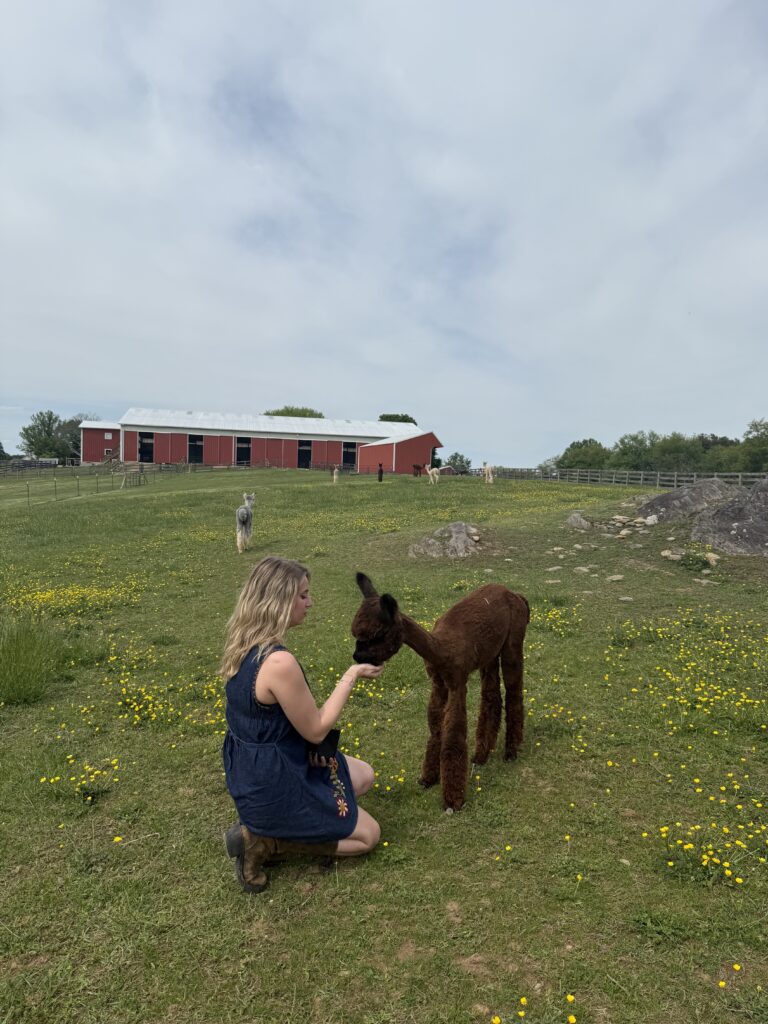
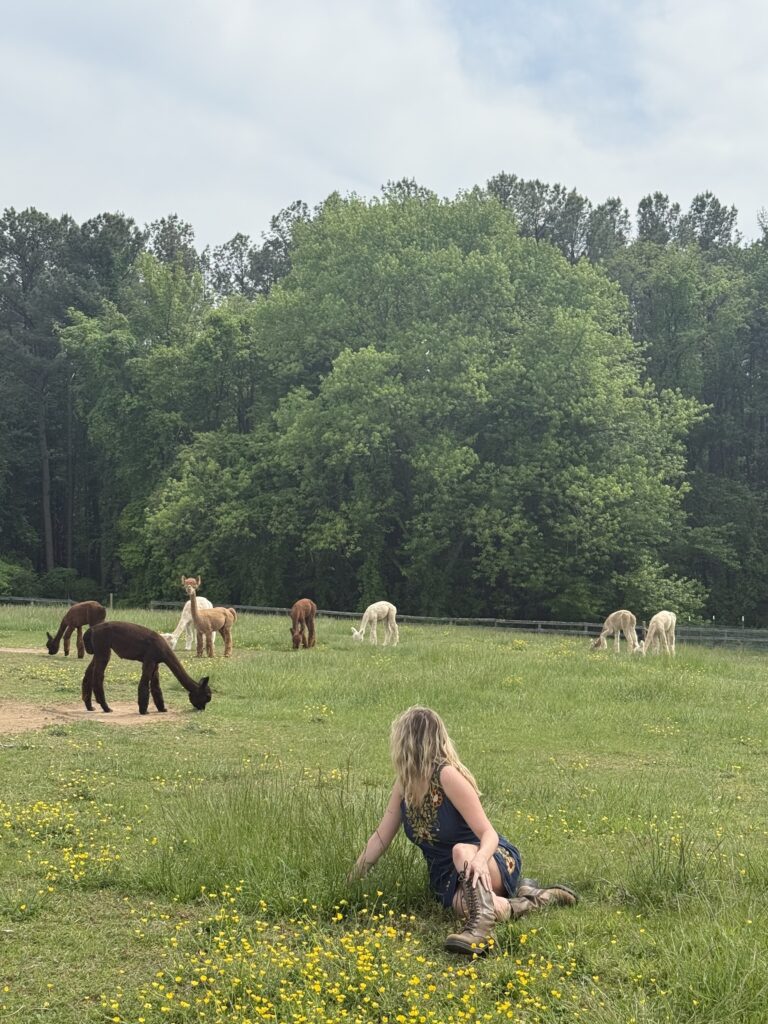
Seriously—this story’s just as much about well-being as it is about wardrobe.
Spending time at Black Barn Alpacas doesn’t feel like a lesson in sustainability—it feels like a literal breath of fresh air. You can wander the pastures, take in the quiet, and wait for these curious little creatures to wander up and check you out. It’s calm, it’s grounding, and somehow it resets you without even trying. You breathe deeply. You listen to the low, almost meditative hum of alpacas communicating with each other and let it settle your nervous system in real time.
And then, if you’re lucky, you make eye contact with one of these fuzzy creatures and realize—you’re fine. The to-do list can wait. Your shoulders drop. Your brain quiets.
Alpacas are like walking mindfulness reminders. Calm, curious, and delightfully weird in the best way. Whether you’re petting one, walking beside one, or just observing from the picnic tables in the barn, something shifts.
You leave lighter than you came. And isn’t that what we’re all chasing?
From Texas Roots to Maryland Meadows: The Story of Black Barn Alpacas
Yussy and Travis McManus didn’t start out as alpaca farmers. Travis grew up on a cattle ranch, and Yussy was an interior designer with a serious love for textiles. But somewhere between their creative roots and agricultural backgrounds, they found themselves drawn to alpacas.
Their alpaca journey started in San Antonio, Texas, with a modest herd of 20. But as their passion (and their herd) grew, so did their dream. In July 2023, they packed up their operation and relocated to Finksburg, Maryland—drawn not only by the lush landscape and ideal climate for alpaca farming, but also by their family ties to the area, which made the move feel like a homecoming.
Now, Black Barns Alpaca Farm is their labor of love—and a place where every animal is cherished, every visitor leaves a little lighter, and every square inch of pasture tells a story about care, climate, and connection.
Today, Black Barn Alpacas now spans 50 acres and is home to nearly 140 alpacas—and every single one has a name picked just for them. These aren’t random or recycled names. Each one reflects the alpaca’s look, quirks, or personality. I have no idea how Yussy and Travis remember them all, but somehow, they do. It’s not just impressive—it’s a reflection of how personally and intentionally they care for every animal here.
These alpacas aren’t just livestock. They’re treated like family. One of them was even house-trained (you read that right). That kind of connection doesn’t happen by accident—it’s the result of daily care, intentional living, and a whole lot of heart.
The baby alpaca, just hours old, didn’t have a name yet, and visitors were joking about calling her “Fleece Witherspoon” after the actress. But Travis reminded us, names have to mean something. Because this isn’t just a farm. It’s a philosophy: care, climate, and connection, woven into everything they do.
Want to Visit Black Barn Alpacas?
You can! Black Barn Alpacas is located in Finksburg, Maryland, and visits are by reservation only. Just head to Black Barn Alpacas to book yoga with alpacas, a Full Moon Yoga Hike, a private tour and much more.
Quick tips:
- Wear closed-toe shoes (you’re on a farm, after all).
- Bring your camera—you’ll want it.
- They have snacks and restrooms, and yes, there’s plenty of free parking.
Whether you’re in it for the fuzzy selfies or the sustainability inspo, it’s a must-do Maryland escape.
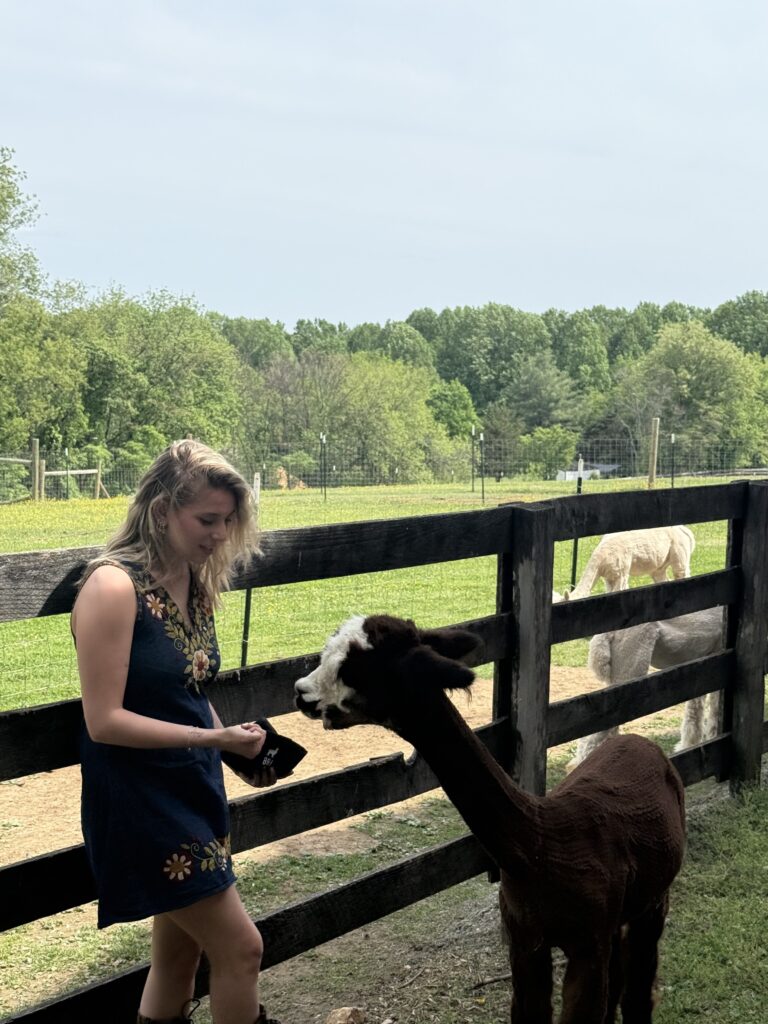
Follow me on my socials:
- Instagram: @lexysilverstein
- Youtube: Lexy Silverstein
- Twitter: @eLEXYfy
- TikTok: @lexysilverstein
- Facebook: Lexy Silverstein
- Liketoknow.it/lexysilverstein


